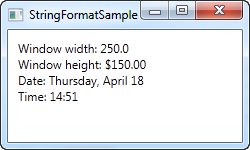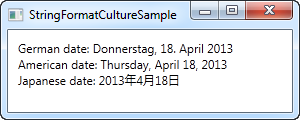The StringFormat property
As we saw in the previous chapters, the way to manipulate the output of a binding before is shown is typically through the use of a converter. The cool thing about the converters is that they allow you to convert any data type into a completely different data type. However, for more simple usage scenarios, where you just want to change the way a certain value is shown and not necessarily convert it into a different type, the StringFormat property might very well be enough.
Using the StringFormat property of a binding, you lose some of the flexibility you get when using a converter, but in return, it's much simpler to use and doesn't involve the creation of a new class in a new file.
The StringFormat property does exactly what the name implies: It formats the output string, simply by calling the String.Format method. Sometimes an example says more than a thousand words, so before I hit that word count, let's jump straight into an example:
<Window x:Class="WpfTutorialSamples.DataBinding.StringFormatSample"
xmlns="http://schemas.microsoft.com/winfx/2006/xaml/presentation"
xmlns:x="http://schemas.microsoft.com/winfx/2006/xaml"
xmlns:system="clr-namespace:System;assembly=mscorlib"
Title="StringFormatSample" Height="150" Width="250"
Name="wnd">
<StackPanel Margin="10">
<TextBlock Text="{Binding ElementName=wnd, Path=ActualWidth, StringFormat=Window width: {0:#,#.0}}" />
<TextBlock Text="{Binding ElementName=wnd, Path=ActualHeight, StringFormat=Window height: {0:C}}" />
<TextBlock Text="{Binding Source={x:Static system:DateTime.Now}, StringFormat=Date: {0:dddd, MMMM dd}}" />
<TextBlock Text="{Binding Source={x:Static system:DateTime.Now}, StringFormat=Time: {0:HH:mm}}" />
</StackPanel>
</Window>

The first couple of TextBlock's gets their value by binding to the parent Window and getting its width and height. Through the StringFormat property, the values are formatted. For the width, we specify a custom formatting string and for the height, we ask it to use the currency format, just for fun. The value is saved as a double type, so we can use all the same format specifiers as if we had called double.ToString(). You can find a list of them here: http://msdn.microsoft.com/en-us/library/dwhawy9k.aspx
Also notice how I can include custom text in the StringFormat - this allows you to pre/post-fix the bound value with text as you please. When referencing the actual value inside the format string, we surround it by a set of curly braces, which includes two values: A reference to the value we want to format (value number 0, which is the first possible value) and the format string, separated by a colon.
For the last two values, we simply bind to the current date (DateTime.Now) and the output it first as a date, in a specific format, and then as the time (hours and minutes), again using our own, pre-defined format. You can read more about DateTime formatting here: http://msdn.microsoft.com/en-us/library/az4se3k1.aspx
Formatting without extra text
Please be aware that if you specify a format string that doesn't include any custom text, which all of the examples above does, then you need to add an extra set of curly braces, when defining it in XAML. The reason is that WPF may otherwise confuse the syntax with the one used for Markup Extensions. Here's an example:
<Window x:Class="WpfTutorialSamples.DataBinding.StringFormatSample"
xmlns="http://schemas.microsoft.com/winfx/2006/xaml/presentation"
xmlns:x="http://schemas.microsoft.com/winfx/2006/xaml"
xmlns:system="clr-namespace:System;assembly=mscorlib"
Title="StringFormatSample" Height="150" Width="250"
Name="wnd">
<WrapPanel Margin="10">
<TextBlock Text="Width: " />
<TextBlock Text="{Binding ElementName=wnd, Path=ActualWidth, StringFormat={}{0:#,#.0}}" />
</WrapPanel>
</Window>
Using a specific Culture
If you need to output a bound value in accordance with a specific culture, that's no problem. The Binding will use the language specified for the parent element, or you can specify it directly for the binding, using the ConverterCulture property. Here's an example:
<Window x:Class="WpfTutorialSamples.DataBinding.StringFormatCultureSample"
xmlns="http://schemas.microsoft.com/winfx/2006/xaml/presentation"
xmlns:x="http://schemas.microsoft.com/winfx/2006/xaml"
xmlns:system="clr-namespace:System;assembly=mscorlib"
Title="StringFormatCultureSample" Height="120" Width="300">
<StackPanel Margin="10">
<TextBlock Text="{Binding Source={x:Static system:DateTime.Now}, ConverterCulture='de-DE', StringFormat=German date: {0:D}}" />
<TextBlock Text="{Binding Source={x:Static system:DateTime.Now}, ConverterCulture='en-US', StringFormat=American date: {0:D}}" />
<TextBlock Text="{Binding Source={x:Static system:DateTime.Now}, ConverterCulture='ja-JP', StringFormat=Japanese date: {0:D}}" />
</StackPanel>
</Window>

It's pretty simple: By combining the StringFormat property, which uses the D specifier (Long date pattern) and the ConverterCulture property, we can output the bound values in accordance with a specific culture. Pretty nifty!
<TextBlock Text="{Binding CelsiusTemp, StringFormat={}{0}°C}" />
The StringFormat property的更多相关文章
- 【WPF系列】Textbox
Style定义实例 给Textbox定义一个阴影效果. <Style x:Key="{x:Type TextBox}" TargetType="{x:Type Te ...
- 同时使用Binding&StringFormat 显示Text【项目】
Case ID (?unit) 红色的字根据一个后台boolean来做trigger,可以是Case or Open 蓝色的字binding到后台的一个string属性来切换任意的Unit单位 这样一 ...
- wpf Content数据绑定StringFormat起作用的原理和解决(转)
1.简单示例: <Window x:Class="WpfOne.Bind.Bind6" xmlns="http://schemas.microsoft.com/wi ...
- wpf数据绑定 - StringFormat的妙用
写在前面 WPF中常常有这样的情况:需要在UI上显示一些信息,比如显示一张图片的信息,信息结构是: 图片名:Xxx 图片尺寸:Xxx 而其中的 Xxx 通常通过数据绑定来获得, Xxx 前面的内容是需 ...
- wpf Content数据绑定StringFormat起作用的原理和解决
原文:wpf Content数据绑定StringFormat起作用的原理和解决 <Window x:Class="WpfOne.Bind.Bind6" xmlns=" ...
- How do you create a DynamicResourceBinding that supports Converters, StringFormat?
原文 How do you create a DynamicResourceBinding that supports Converters, StringFormat? 2 down vote ac ...
- 探究@property申明对象属性时copy与strong的区别
一.问题来源 一直没有搞清楚NSString.NSArray.NSDictionary--属性描述关键字copy和strong的区别,看别人的项目中属性定义有的用copy,有的用strong.自己在开 ...
- JavaScript特性(attribute)、属性(property)和样式(style)
最近在研读一本巨著<JavaScript忍者秘籍>,里面有一篇文章提到了这3个概念. 书中的源码可以在此下载.我将源码放到了线上,如果不想下载,可以直接访问在线网址,修改页面名就能访问到相 ...
- -Dmaven.multiModuleProjectDirectory system property is not set. Check $M2_HO 解决办法
最近在使用maven,项目测试的时候出现了这么一个错.-Dmaven.multiModuleProjectDirectory system property is not set. Check $M2 ...
随机推荐
- 访问javaweb服务器sessionid存放问题
sessionid存放在cookies里面,key是JSESSIONID
- 二、JavaScript语言--JS基础--JavaScript进阶篇--JavaScript内置对象
1.什么事对象 JavaScript 中的所有事物都是对象,如:字符串.数值.数组.函数等,每个对象带有属性和方法. 对象的属性:反映该对象某些特定的性质的,如:字符串的长度.图像的长宽等: 对象的方 ...
- LoadRunner 思考时间与事务响应时间的区别与关系
LoadRunner 思考时间与事务响应时间的区别与关系 思考时间lr_think_time 就是一个事务要开始时思考的时间;比如 你要点击一个 登录按钮 我们都要点击这个按钮要先思考下 就是人为 ...
- AJAX 汽车详细信息练习
<!DOCTYPE html PUBLIC "-//W3C//DTD XHTML 1.0 Transitional//EN" "http://www.w3.org/ ...
- 【数据库】 防止sql注入,过滤敏感关键字
private bool FilterIllegalChar(string sWord) { var result = false; var keyWord = @"select|inser ...
- poj 1195:Mobile phones(二维线段树,矩阵求和)
Mobile phones Time Limit: 5000MS Memory Limit: 65536K Total Submissions: 14391 Accepted: 6685 De ...
- maven File encoding has not been set
原pom.xml配置文件: <?xml version="1.0" encoding="UTF-8"?> <project xmlns=&qu ...
- Go 中的反射要点
简介 反射是元数据编程的一种形式,指的是程序获得本身结构的一种能力.不同语言的反射模型实现不一样,本文中的反射,仅仅指的是Go语言中的反射模型. 类型以及接口 这个基本概念需要清晰,这里不详细展开. ...
- golang json 包简单分析
首先上代码: func main() { b := true a1, _ := json.Marshal(b) a2, _ := Marshal(b) fmt.Println(string(a1)) ...
- 无法启动程序 ”*.lib”
解决办法: 把含有入口函数(main函数)的 工程 如 cpp-test 设置为启动项 具体操作: 选中 cpp-test 工程 右击 —> 设为启动项目
